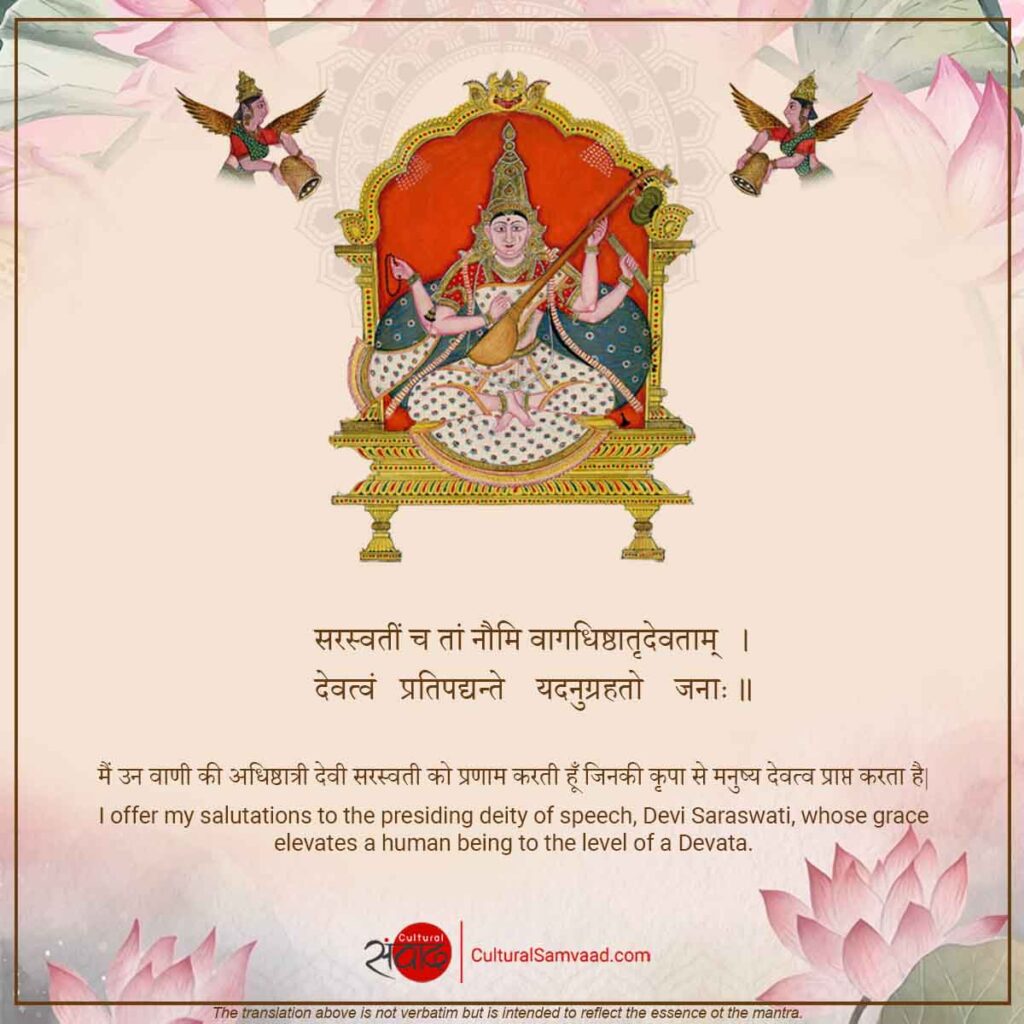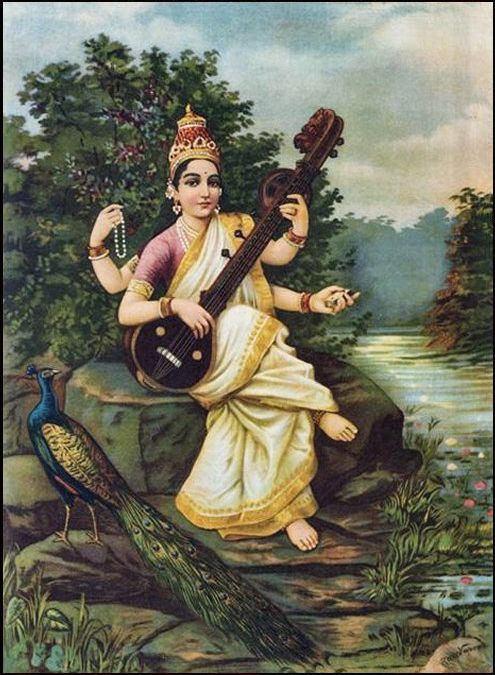She is the epitome of purity. She bestows true knowledge. She nurtures the intellect. She incites pious thoughts and actions. She is eternal. She is transcendental. She is Maa Saraswati (Mother Saraswati).
Join Cultural Samvaad’s WhatsApp community

From being praised as a mighty and all-powerful river in the Rig Veda to becoming the presiding deity (adhishatri devi) of vidya (knowledge), Saraswati is also a cultural icon who transcends geographical and religious boundaries. Saraswati is revered in the Hindu, Jain and Buddhist traditions. Even Benzaiten, a goddess worshipped in Japan owes her origin to the Indian Saraswati .
The Story of Saraswati – From the river goddess to the goddess of learning
True knowledge is complex and enveloped in sheaths that need to be pierced for its attainment. Like true knowledge, the origin and development of the patron deity of knowledge is also hidden behind sheaths of evidence (literary, material – archaeological, and geological). It is however clear, that she has been imbued with divinity for over four millennia now.
Saraswati in the Rig Veda is the embodiment of the Saraswati river. This is no ordinary river. The river is said to have originated in the heavens and flowed on the earth. Saraswati is extolled as a great and powerful river – majestic, impetuous and vast and is the mother of waters.
अम्बितमे नदीतमे देवितमे सरस्वति । (RV. 2.41.16)
ambitame nadītame devitame sarasvati ।
Oh Mother Saraswati, you are the best among mothers, you are the best among rivers (you bestow true knowledge), you are the best among goddesses (you bestow splendour and lustre).
The mighty Saraswati got ‘lost’ as a river over the centuries, and in the Brahmanas and in the Yajur Veda is identified with speech (vaak or vaach). In Post Vedic literature, the references to her as a river kept fading away except stray instances (Kalidasa alludes to her disappearance in Abhijnanashakuntalam and the great Indian epic – Mahabharata also refers to the same). During the Puranic period she developed into the goddess of learning and the mother of the Vedas as we know her today.
While the waters of the Saraswati may have been lost, her memories and ‘myths’ were never lost. She continues to be worshipped as the invisible third river in the holy triveni sangam (confluence of three rivers) at Prayagraja in Uttar Pradesh (earlier Allahabad). Ganga and Yamuna are the other two rivers at the triveni sangam. The search for the mighty river Saraswati continued and continues till date.
इस लेख को हिन्दी में पढ़ें|
Saraswati of the Harappa or Sindhu-Saraswati Civilisation?
Over the past few decades, scholars such as B.B. Lal, S.P. Gupta, Dilip Chakrabarti and V.N. Misra have surmised that she was the same river on whose banks a large number of sites of the Harappan civilization flourished – the Ghagghar-Hakra belt. In the words of V.N. Misra – “The description of the location, size and desiccation of the Saraswati river in the Vedic, epic and classical literature perfectly matches with the features and history of the Ghaggar-Hakra river. Therefore, it can be stated with certainty that the present Ghaggar-Hakra is nothing but a remnant of the Rigvedic Saraswati which was the lifeline of the Indus Civilization.” S.P. Gupta proposed that the Indus Civilization should be called the Indus-Saraswati Civilization – an idea that is still being debated but has considerable merit. (‘The Lost River’ by Michel Danino is an excellent work that the reader may want to refer to for a detailed discussion of this debate around Saraswati.)
Saraswati – The one who purifies and awakens our consciousness
While Saraswati is indisputably the goddess of wisdom and knowledge, is the mother of all arts and the Vedas, is specially invoked by children before they commence their education; it is important to remember that invoking her is not limited to praying for academic excellence or excellence in the arts. Rig Veda 1.3.10-12 reminds us of the deeper and eternal meaning of her invocation. पावका नः सरस्वती – she purifies us, चोदयित्री सून्र्तानां – she inspires true action, चेतन्ती सुमतीनाम – she awakens and heightens our consciousness and धियो विश्वा वि राजति – she illuminates all thought and intellect. (Paraphrasing after Satwalekar and Aurobindo).
Even iconographically, Saraswati attired in pristine white and sitting on a white lotus symbolizes purity. Her vehicle – the swan (hansa) is legendary for neer-ksheer viveka (the intellect to separate milk from water). When one worships Saraswati; one essentially prays for purity of thoughts and actions, for vidya (wisdom/knowledge) to distinguish between right and wrong and for awakening of our inner consciousness. That is our eternal quest and that is what the eternal Saraswati bestows upon us. The Saraswati flows on…and will flow on till eternity. (The Saraswati flows on is in the title of B.B. Lal’s famous work).

या कुन्देन्दुतुषारहारधवला या शुभ्रवस्त्रावृता
या वीणावरदण्डमण्डितकरा या श्वेतपद्मासना।
या ब्रह्माच्युतशङ्करप्रभृतिभिर्देवैः सदा वन्दिता
सा मां पातु सरस्वती भगवती निःशेषजाड्यापहा॥
She is pristine and white like the jasmine flowers, like the moon, like ice and like a garland of pearls. She is adorned in pure white clothes and is seated on a white lotus. She has a veena (a lute) in her hands and is praised by Brahma, Vishnu, Mahesh and the devatas. She is Maa Saraswati. I pray to her to dispel my ignorance and to protect me.
Select References:
- Danino, Michael (2010).The Lost River: On the Trail of the Sarasvati. Penguin Books India.
- Ghose, Aurobindo (1998). The Secret of the Aurobindo Ashram.
- Kinsley, D. (1986).Hindu Goddesses: Visions of the Divine Feminine in the Hindu Religious Tradition. University of California Press.
- Lal B.B. (2002).The Sarasvatī flows on: the continuity of Indian culture. Aryan Books International.
- Misra, V. (2001). The Role Of The Rigvedic Sarasvati In The Rise, Growth And Decline Of The Indus Civilization. Annals of the Bhandarkar Oriental Research Institute, 82(1/4), 165-191.
- Satwalekar, Damodar (2011). Rig Veda Ka Subhodha Bhashya – Volumes I & II. Swadhaya Mandal, Pardi.


Knowledge brushing..
Thanks Patiji.